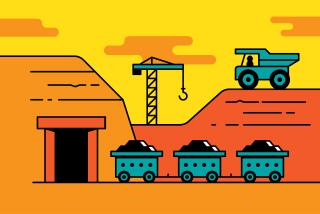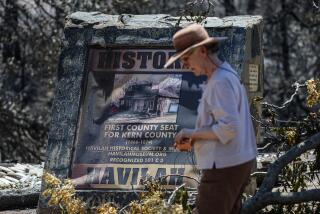California: Yreka a gold mine of natural wonders
YREKA, Calif. — Deep in Siskiyou County in far Northern California, high granite peaks and rocky streams have long incited gold miners, including my grandfather, who in the 1930s lived with his family — my grandmother, mother and aunt — in a two-room cabin near the Dewey gold mine southwest of Yreka.
My mother, who doesn’t remember much about the area because she was 3 when they left, and I recently headed to this beautiful backwater to find out what we could about the gold mine where my grandfather worked and to bask in the region’s simple charms.
Gold fever here dates back nearly as far as the famous Sierra Nevada gold rush. In March 1851, a mule-train packer named Abraham Thompson saw flakes of gold among the grass roots that his mules were eating near Black Gulch. Word got out, and by April, 2,000 miners were hoping to strike it rich at Thompson’s Dry Diggings.
Within three months, tents and shanties had created a gold-rush boomtown. Several name changes occurred, but today the city is called Yreka. And though the region never garnered the fame of the Sierra Nevada and its gold rush, the amount of gold recovered here over the years is a mother lode itself: Millions of dollars’ worth is said to have been mined in the area.
Miner Street, the heart of Yreka’s historic district, is much quieter than in its heyday, a western fantasy of false-fronted buildings and balcony-shaded sidewalks, gentrified by restaurants, antiques shops and the Yreka Chamber of Commerce, where we start our quest for information.
“We’re looking for the Dewey mine,” I told the tourism rep. “We have a vague idea, but…” She pulled out a map and ran her fingers across the lines. “Hmm,” she said. “If anyone would know, it’s my son. He’s a hunter and knows all those back roads.” She called him and, sure enough, he said he knew exactly where it was: “Simply take the road out of Stewart Springs,” he said through her. “But why would anyone go there? It’s just a bunch of ruined buildings.”
“If you’re looking for gold,” the woman continued, “you must visit the million-dollar gold display in the Siskiyou County Courthouse. It’s the largest such display south of Alaska.” At least it was a concrete plan, so off we went to the towering government building constructed in the mid-1850s.
Behind a wall of glass in the foyer (and in view of the building’s security staff) lie piles of gold extracted in the county: huge nuggets, flakes and dust — all unpolished, rough and worth about $3 million. This is the same collection (minus some choice pieces that were stolen in the dark of night in February) that was displayed at the 1939 World’s Fair in San Francisco to show the world the extent of riches found in Siskiyou County.
We strolled up West Miner Street, my mother taking a particular interest in No. 319, a historic building that now holds a scrapbooking shop. A sign indicated that the city’s meat market, established in 1854, was housed here and in continuous operation until closing in 2009. My grandmother refers to the market in one of her letters to her family: In those Depression-era days, she bought a mere “0.08 cents worth of stew meat this morning and the man almost threw it at me.”
At the tourism bureau’s suggestion, we found the Yreka Third Street Inn, housed in a dollhouse-like 1897 Victorian; we stayed in the Rose Room, cozy with its hand-crocheted bedspreads and floral wallpaper. Innkeeper Hedley Cooper recommended a couple of places to eat on West Miner Street, each housed in a historic structure. We chose the casual Brickhouse pizzeria, where we enjoyed vegetarian pizza and a simple green salad. (The homemade vinaigrette alone is worth coming back for.)
The next morning, hoping to find more information, my mother and I headed to the small Siskiyou County Museum, also on Miner Street, with impressive displays of the region through the ages. On a wall, I discovered a sepia-toned photo of the Dewey mine, with a row of men hanging out in front of its wooden shaft. The photo was dated before my grandfather’s time, but this must have been the mine where he worked.
The receptionist was kind enough to indulge our curiosity, and she pored over maps and books that she pulled from the back room, to no avail. Dewey mine, she said, had been one of the biggest, but it closed in 1907.
“Maybe my father was hired to try to reopen it,” my mother said.
We head south and west out of Yreka on California Highway 3, through long, golden Scott Valley with its cows, horses and backdrop of granite (gold-filled) peaks. We passed through Fort Jones, named after a military outpost established there in 1852.
At the nearby Forest Service office, we told a ranger about our quest. He studied several Forest Service maps but even he seemed a bit perplexed about our mine. Finally, he pinpointed it somewhere east of Mountain House Creek and north of China Mountain, and noted a road leading south off Gazelle-Callahan Road to reach it.
“What’s the road like?” I asked.
“Dirt,” he says. “You’ll need an SUV to get there.”
Continuing south on Highway 3, we came to Etna, where my grandparents had a post-office box. I’ll bet the little town hasn’t changed much since they were here; it’s essentially one street with western facades, the highlight being Scott Valley Drug, in business since 1902. The drugstore has an old-fashioned walk-in safe to hold the gold nuggets that were exchanged for goods and an 1800s soda fountain with a pine back bar.
We had lunch at the Etna Brewing Co., which served delicious salads, soups and sandwiches — and locally brewed beer — on its sunny patio. We both had the delicious pub chili, the secret of which is Old Grind Porter (a dark-brown beer) added to the spicy sauce. Afterward, we headed along the Scott River, noticing rock pilings left from mining days. We didn’t spot any modern miners, though gold panners and dredgers still forage the area. We passed through the ghost town of Callahan, its buildings looking as though a slight breeze could tip them over.
We veered onto Gazelle-Callahan Road, climbing, twisting and turning through gorgeous pine-forested mountains. In the distance, jagged, gun-gray peaks march in rows.
I studied the map and saw that based on what the Forest Service ranger told us, the turnoff to the mine occurred after a huge U curve in the road. It looked as though we were driving along such a U, and just as I glanced to the right and saw a dirt lane winding into the forest, the road crested and dropped down the other side of the mountain in a series of precarious switchbacks.
“I think that’s the road to the mine!” I said.
But my mother was driving too fast, and there are no turn-arounds. Maybe she was concerned about getting stuck on a rutted dirt road — or perhaps she didn’t want to disturb sleeping ghosts, but there was no turning back.
As we zoomed down the mountain at a faster speed than my grandparents could ever have imagined in their Depression-era Ford, I knew one thing for sure: The region is worth a visit just for its gold mine of natural splendors.
More to Read
Sign up for The Wild
We’ll help you find the best places to hike, bike and run, as well as the perfect silent spots for meditation and yoga.
You may occasionally receive promotional content from the Los Angeles Times.






